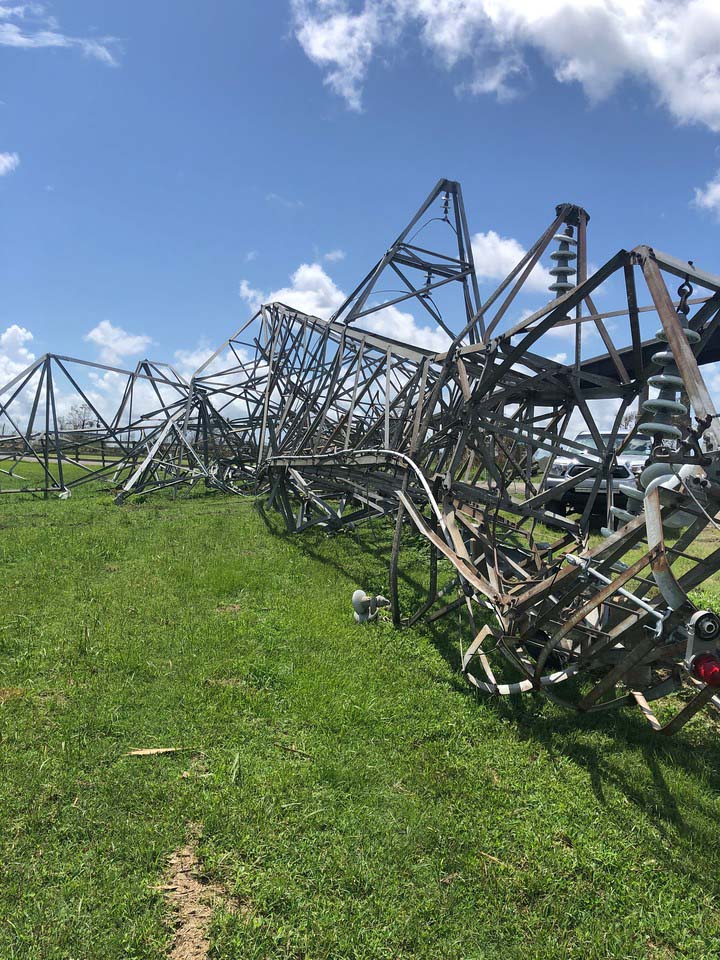
Once the huge job of restoring power from Hurricane Helene is done, some electric cooperatives in the Southeast face an even more daunting task: completely rebuilding their systems destroyed by the storm’s ferocious winds and flooding rains.
“This is not just a matter of power outages; it’s about lives turned upside down, homes lost and communities facing weeks—if not months—of recovery,” Thomas Golden, CEO of EnergyUnited in Statesville, North Carolina, said at a news conference hosted by NRECA last week.
“Some of our hardest-hit areas are not dealing with a simple fix. They’re facing a complete rebuild of their electrical infrastructure, their roads and even their daily lives.”
Co-ops have an especially tough task of rebuilding because they serve some of the most remote areas of the country, said Mike Couick, president and CEO of the Electric Cooperatives of South Carolina.
One of the state’s co-ops, Blue Ridge Electric Cooperative in Pickens, saw its underground power lines wash down the mountainside, along with trees and power poles, Couick said.
“They’re rebuilding a system of 7,300 miles of line,” he said. “That’s almost the diameter of the planet Earth. And it runs straight up mountainsides.”
Ron Barnes, president and CEO of Coast Electric Power Association in Bay St. Louis, Mississippi, knows better than most what it means to rebuild a co-op system after a disaster. He was working at the co-op as vice president of marketing, member services and public relations when Hurricane Katrina ravaged the Gulf Coast in 2005.
Coast Electric lost 30,000 power poles and 10,000 transformers. It took a full year and $110 million for the co-op to rebuild its system, with major funding from the Federal Emergency Management Agency.
“It’s not as dark as it seems at the moment,” he advises co-ops hit by Hurricane Helene. “You have all these pressures on you, and you say, ‘Oh my gosh, how are we ever going to do this?’ It seems like it will never end when you’re in the middle of it, but it does.”
The co-op restored power in just three weeks to members whose homes and businesses were still standing after Katrina.

“If you’re our member and you used to get power through Substation A and that substation is down, we can route you through Substation B,” Barnes said.
“The immediate goal of every co-op after a hurricane is to get your lights back on as quickly as possible. But then we’ve got to go back and rebuild everything that was lost.”
At the peak of Katrina, Coast Electric had 3,200 people working to restore power. After that, it kept 500 contract employees working with its own crews for a year to rebuild the system, Barnes said.
An essential part of rebuilding is replacing crucial equipment, including transformers, power poles and overhead line splices used to reconnect broken distribution lines.
United Utility Supply, which is owned by electric co-ops in 20 states, had already sent out about 500 to 600 transformers to storm-damaged co-ops within the first few days after Hurricane Helene, said Phil Clark, vice president of sales and operations.
The not-for-profit Louisville, Kentucky-based supply co-op keeps about 10,000 transformers on hand throughout its eight warehouses, Clark said. The transformer shortages caused by the COVID-19 international supply chain crisis are no longer a significant problem, he said.
“We run our own truck fleet,” Clark said. “We prepare for a storm just like the co-ops do. We line up warehouse teams, and drivers will take multiple loads per day and night directly to the co-ops.”
Co-ops typically take out loans to pay for the equipment, then seek reimbursement from FEMA after they rebuild, he said.
UUS gets some unusual requests from co-ops during restorations, such as hundreds of Styrofoam cups and plates to serve food to mutual aid crews that have come in from other co-ops to help restore power. Clark turned to a restaurant supply company to help it fulfill that request.
“A co-op also may run out of something that they use all the time,” he said. “Instead of them having to track down an alternative part, we’ll find the next best thing that meets the specs and get it to them.”
When a co-op is rebuilding, it can often find ways to make its system better, said Mike Heinen, CEO of Jeff Davis Electric Cooperative in Jennings, Louisiana. JDEC is still rebuilding parts of its transmission system more than four years after it was walloped by back-to-back hurricanes Laura and Delta in 2020.
“Along the coast, all of my metal transmission towers went down,” Heinen said. “You can’t just throw up new metal towers. The system crosses two rivers and a waterway. I have to go through the Army Corps of Engineers, the Department of Natural Resources and probably five other federal agencies to sign off on it all.”
When it’s all done next June, the co-op will have a larger transmission system, putting in a FEMA-approved 230-kilovolt line to replace a 69 kV line, he said.
“My advice to co-ops going through this now is: Try not to look at the whole picture, because if you do, you’ll give up. Take it a day at a time, a piece at a time, and eventually it all comes together.”
Erin Kelly is a staff writer for NRECA.
Earlier Coverage of Hurricane Helene:
- ‘The Bridges Are Gone, the Roads Are Gone’: How One Co-op Is Coping With Helene
- Co-ops Face Grueling Restoration Work in the Wake of Helene
- For Co-ops Grappling With Helene’s Destruction, It’s All Hands on Deck
- Line Crews Lean on Cooperative Spirit in the Wake of Helene’s Destruction
- ‘This Is an Unprecedented Situation’: Co-ops Pick Up the Pieces After Helene
- Hurricane Helene: Tracking the Co-op Response
- Co-ops Faced With 1.25 Million Outages in the Wake of Hurricane Helene